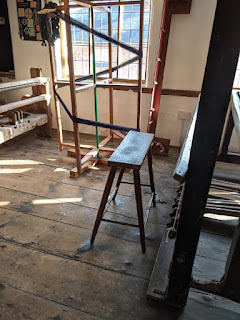There are notable museums around the world, but my joy is in finding the tiny local museum with the back story, the local story, the bits that nobody sees. Knowing this my daughter took me to this small jewel in Newtown. The Newtown Textile Museum is not open often, so finding this special weaving event was an opportunity to be grabbed.
For the Bad Knees traveler there are a couple of notes here: It is not wheelchair accessible, and there are stairs. But as you take your time going up and down, there is a lot to look at. Parking is on the street, not always where you want it. There is a train that stops in Newtown, lots of small pub style and BnB accommodations within easy walking.
The photos here are not necessarily my best, but I tried to get for you the best flavor of the place. And there are lots of photos that I didn’t take. Trying to keep up with two small excited people is sometimes the priority. Most of the photos here were taken by myself.
Make sure to check their website as their open hours are variable.
Built in the early 1800s, the building is a typical of the woolen mills in Wales of the day. The bottom two stories housed 6 households. The ground floor was for eating and the business of running the house and a stair case up to the first floor. (Note to Americans that do not understand the European style of numbering floors. What we would call the first floor is the ground floor. One flight of stairs up is the first floor.)
There were no other rooms, no closets. There might be a cupboard under the stairs, and if you were really really lucky you might get this place for your room.
The three black doors and the six white windows were the three units on this side. The other three units were on the other.
The archway is a narrow passage that leads to the courtyard behind the building.
Behind the building, in the courtyard, was the tŷ bach, or small house. The two door outhouse for all six households, and for the two factory floors upstairs.
The museum has used one of these apartments to create the staircase to the upper displays and workrooms. The original staircase to the work rooms was outside in the court yard. They have recreated one of the homes into rooms as they would have been seen. Again I didn’t get my photos here because the smalls were rushing to the interesting stuff on the top floors.
 Floor two had the big looms. Beautiful, old looms that each has their own story to tell.
Floor two had the big looms. Beautiful, old looms that each has their own story to tell.This being a special event day, there was a woman doing a lovely green piece of fabric.
There were lots of equipment that one does not usually get to see, like this frame to wind long lengths of yarn.
Here is the scale to weigh the fleece. Note the large basket to the right. I have become aware of how much baskets were integral in farm life. Note the amount of light from the windows. This was important, and can be seen in the local architecture. Long narrow buildings built to take in as much light as possible.
There is lots of info on some of the terms that we no longer use, or that definitions have shifted over time: flannel, worsted, felled (felt).
Floor three has the spinning displays. A lovely woman gave the girls a homie talk on what she was doing, and how she was spinning in a specific way for the sweater she had promised herself. She told them a lot about how they would be living in the early 1800s. She didn’t tell them that there would have been a 50/50 chance of them actually surviving to adulthood. And that by age 6 they would be working full time.
There was a display of what a cobbler shop would have looked like. again, notice the window. With only sun light to work by, the work shop was situated to get the most daylight possible.
Check out the description in the adverts. I think the adverts would have been from the early 20th century. These clogs were sturdy working shoes. Deep wooden soles with metal cleats. Clog dancing started as reproductions of the sound of wooden shoes on the pedals with the sound of the shuttle and beater. Here too is a display of the inside of a dressmaker’s shop. One is tempted to think that these are smaller than an actual shops would be, but no, this is very much like what one would see.
There are lots of small displays all around the rooms. Clothing, accessories. Awards, tokens, and special bits of tat.The hat is a ‘Welsh Wig’ Welsh wig.
Lest you think kumihimo was a purely Japanese artform.
Two random displays that I did not get time to really explore were about workers rights. One was on how the factory owners could lower the pay scale blaming it on the down turns in the market. The other was on ‘Welsh Cloth’ or ‘Welsh Plains.’ this was the incredibly sturdy fabric made to be used on the slave plantations. https://www.bbc.co.uk/news/uk-wales-48624937
This sort of weaving factory had a very short life. The Welsh weaving industry went from home looms to the total shift to large industrial weaving mills in less than a century.





















Comments